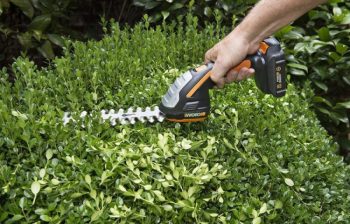Choose the Right Tools for Pruning Your Trees & Hedges
Pruning Equipment – Choose the Right Tool for the Job
Late winter is the ideal time to prune most deciduous trees and shrubs. At this time of year, trees are dormant and experience less stress compared with plants pruned during active growth. Most disease agents are also dormant, minimizing the spread of disease. And since the leaves have fallen off plants for winter, the branching structure is easy to see.
As you head outside to prune your trees and shrubs, it is important to select the proper tool. There are many different tools available for pruning and each has a unique purpose.
Hand-Powered Tools
Let’s start by looking at basic hand tools: pruners and loppers. These tools differ mainly in size and both come with two different types of blades – an anvil blade or a bypass blade. To distinguish between these, look at how the cutting blades come together.
• Bypass Blades: The two blades move past one another as they cut, much like scissors, leaving a clean cut. Bypass pruners and loppers are used to cut living plant tissues.
• Anvil pruners: The top blade closes against the bottom blade. Anvil pruners and loppers are used to cut dead branches. They do not cut cleanly through living tissues.
Hand pruners and loppers are similar, differing mainly in the size of branches they can cut. As the name suggests, hand pruners are small and the entire tool fits easily in the hand. Loppers have long handles that provide leverage to cut thicker branches. While individual products vary, the following will help guide you in selecting the proper tool.
• Hand Pruners: Designed for small jobs and typically cut branches up to ¾ of an inch in diameter.
• Loppers: Used to cut larger stems up to 1 ¾ inches in diameter, depending on the lopper. Some loppers are designed with a ratchet or geared system to provide even more cutting power.
For branches larger than 1 ¾ inches, a pruning saw is necessary. There are many different types of hand-held pruning saws, all of which typically have a curved cutting blade attached to a handle. Pruning saws have a narrow blade and coarse teeth that cut when pulled through the wood.
Hedge Trimmer and Shears
Another common type of pruner is a hedge shear or trimmer. These are designed for clipping foliage and branch tips to create a manicured or formal appearance. Hedge shears have long, flat blades and relatively short handles. Shears may be electric or hand powered. Electric shears such as WORX Power Share Cordless Hedge Trimmers are available with a variety of blade lengths to trim hedges of all sizes. For small jobs and sculpting topiary, WORX 20V Garden Shear and Shrubber provides even greater control.
Pole Pruners and Chain Saws
Pole pruners are used to cut overhead branches that are difficult to reach. Hand-powered pole pruners typically include a saw and a hooked-style lopper at the end, with the lopper used to cut smaller branches and the saw for larger limbs. Hand-powered pole saws are cumbersome to use. WORX 8” and 10” Electric and Battery-Powered Pole Saws are a good alternative. They include a small chainsaw at the end of an extension pole to make quick work of cutting.
Use the three-cut method when removing large, heavy branches to avoid damaging trees and shrubs. The first cut is made on the underside of the limb about a foot away from the trunk across. Cut about one-third of the way into the limb. This cut prevents the weight of the falling limb from peeling the bark back along the trunk. The second cut is made further out on the limb from the first cut and is made all the way through the limb to remove the bulk of the branch. The third and final cut removes the remaining stub and is made near the base of the limb just outside the branch collar (the swollen area where the branch meets the trunk). Do not cut flush to the trunk.
Chainsaws are useful for cutting limbs into smaller pieces once they are on the ground. For homeowners who are not comfortable using a chainsaw, WORX 20V Power Share JawSaw Cordless Chainsaw provides unrivaled safety. The blade and chain remain inside the enclosed housing of the JawSaw to protect the user. And the guard enables you to cut heavy branches up to 4 in. in diameter right on the ground, unlike regular chainsaws.
Safety First
Working overhead can be dangerous and it is important to follow simple safety precautions. First, remember that electricity flows through tree branches and many pruning tools also conduct electricity. Never prune a tree or branch that is within 10 feet of a utility line. Branches move a great distance during pruning and can come into contact with a wire that seems to be out of reach. When a utility line is near, call your local utility company to coordinate pruning.
Second, work from the side when cutting high branches rather than working directly overhead. Wear a hard hat and safety glasses. Also remember that ladders and pruning do not mix. If pruning is needed in a location that cannot be reached with a pole saw from the ground, contact a certified arborist. Finally, wear protective clothing when working with chainsaws including heavy work boots, long pants, gloves, and eye protection.
There are many choices of pruning equipment to choose from. Select the proper tool for the job at hand and keep all equipment in good working order. Before pruning, scan the tree or shrub for potential hazards, such as broken limbs or nearby electric wires. Protect yourself by using the proper personal protective gear. When in doubt, call a certified professional arborist.
Take a look at some of the referenced power tools to help make your pruning jobs that much easier!
The Worx JawSaw:
Cordless 4″ Shear and 8″ Shrubber Trimmer:
These tools and more can be found at Worx.com

